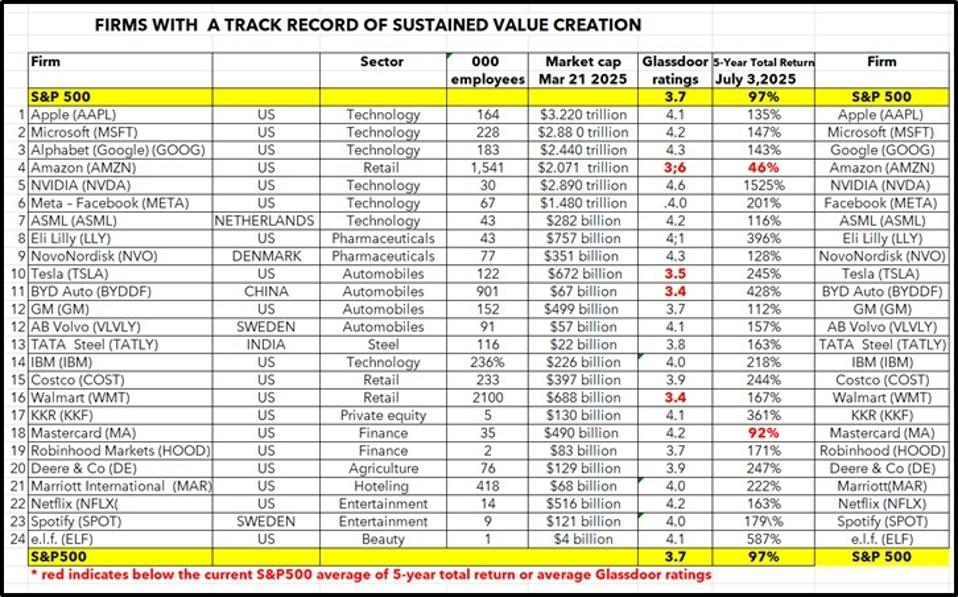In my last article, I gave 21 reasons why managers are becoming obsolete. The low level of employee engagement globally, the meager levels of trust, and the declining returns of many famous firms are dire warning signs that businesses have gotten on the wrong track.
What to do? I offer below the 21 principles of value creating firms, which are mostly operating very differently. The first thing to grasp is that these are principles, not a checklist. This is not just about doing different things. For many, it is about thinking, speaking, interacting and imagining differently. The principles need to be applied in a holistic and integrated way. They need to be interconnected, adaptive, and embodied in everything that occurs in the enterprise. It’s not just about “doing” business differently. It’s about “being” a different kind of business, that is often a lot more profitable.
The 21 Principles Of The Value Creating Firm
The good news is the extraordinary success that firms enjoy when they consistently deploy the principles of value creation. The 21 interconnected ways in which value-creating firms operate differently from traditional firms are:
- Right mindset: creating value for others, not just making profits.
- Right goal: creating more value for customers, not merely becoming more efficient by cutting costs,
- Right way of working: self-driven workers and teams, not bosses directing workers.
- Right firm structure: networks of competence, not steep hierarchies of authority
- Right forward thinking: executing strategies, not just preparing plans.
- Right approach to problem resolution: resolving issues where they originate, if necessary, at the top, not wasting time at the team or unit level if the issue originates at the top.
- Right processes: Using processes that are aligned with the firm’s goal, not autarchic processes, each pursuing its own goal,
- Right budgeting: allocating resources strategically, not a zero-sum battle for resources among the silos,
- Right HR: enabling people as people, not controlling and viewing them as things.
- Right measurement: pursuing outcomes, not just outputs.
- Right use of AI: using AI to add value, not just cutting costs and reducing headcount.
- Right marketing: creating new value for customers, not just selling more existing products.
- Right risk management: reducing actual risk, not just reducing the appearance of risk.
- Right outcomes: growing long-term returns, ahead of focusing on short-term gains.
- Right staffing: recruiting entrepreneurial staff, not dutiful rule-followers.
- Right compensation: compensating everyone equitably, removing excesses at the top.
- Right concept of leadership: seeing leadership as a skill that all people need, not special kinds of people.
- Right skills: growing skills in value creation, not bureaucracy.
- Right management education: drawing on institutions that embrace value creating principles.
- Right economics: prioritize value creation and discard the cost-cutting philosophy of mainstream economics.
- Right management literature: Read books and articles focused on value creation, setting aside works that reiterate, assume, or even celebrate, obsolete thinking,
Why Now?
These principles are not new. Some of them have been around in other fields for thousands of years. (E.g. “Love your neighbor as yourself.”) They have also been urged in management circles over the last hundred years, at least since Mary Parker Follett began promoting them in the 1920s.
Why tackle them now? For many businesses, there’s no other choice: the world has changed. Firms that don’t draw on the talents of their staff to create value for customers will find it hard to compete.
Value-Creating Firms Often Make More Money
The key insight: value-creating enterprises not only satisfy customers: they make much more money than firms focused on making money. Workplaces devoted to creating value for customers are also more likely to be more meaningful workplaces.
A list of major firms that are in many ways on this new track is below. Important caveat: none of these firms is perfect. Some embrace the principles only in parts of their organization. Some embrace the principles and then partly lapsed back into traditional business.
We also need see through the inevitable noise that occurs in capitalist economies when new technology arrives and previously successful firms don’t make the necessary shifts to implement the new technology and are displaced, as Carlota Perez has brilliantly documented in her book, Technological Revolutions and Financial Capital.
How To Transition
Forthcoming articles will discuss how to transition to the implementation the value creation principles. As an appetizer: your five key initial leadership moves towards value creation should include:
- Understanding what’s involved.
- Taking stock of where you are.
- Forming a coalition of the willing.
- Getting clear on the most urgent needs.
- Getting started now!
And read also:
Why Are Millions Of Managers Becoming Obsolete? Here Are 21 Reasons

